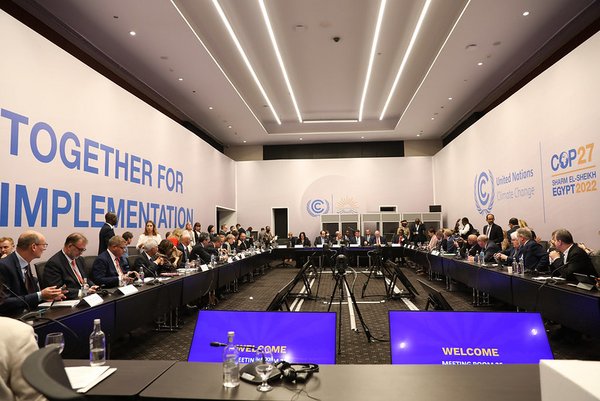 Read this article in French
Read this article in French- Share this article
- Subscribe to our newsletter
Early Warnings for All Action Plan gets backing at COP27
The Executive Action Plan for the UN Early Warnings for All initiative, unveiled at COP27 in Sharm el-Sheikh/Egypt, has been given a unanimous welcome and initial offers of support from government leaders, heads of UN and development agencies, the private sector and civil society, the World Meteorological Organization (WMO) reported on its website in November 2022.
UN Secretary-General Antonio Guterres announced the plan at a meeting of government and UN organisation leaders, financing agencies, Big Tech companies and the private sector during the World Leaders Summit at the UN climate change negotiations, COP27. The plan was drawn up by the WMO and partners, and it was supported by a joint statement signed by 50 countries.
The plan calls for initial new targeted investments of USD 3.1 billion between 2023 and 2027, equivalent to a cost of just 50 cents per person per year to achieve Guterres’ goal of ensuring that everyone on Earth is protected by life-saving warnings against increasingly extreme weather in the next five years.
One of the centrepieces of the conference
“Vulnerable communities in climate hotspots are being blindsided by cascading climate disasters without any means of prior alert,” the UN Secretary-General said at a high-level round table during the Leaders Summit at COP27. “People in Africa, South Asia, South and Central America, and the inhabitants of small island states are 15 times more likely to die from climate disasters. These disasters displace three times more people than war. And the situation is getting worse.”
Sameh Hassan Shoukry, Egyptian Minister of Foreign Affairs and COP27 President remarked that the Early Warnings for All Action plan would be one of the centrepieces of the conference in Sharm el-Sheikh being seen as an “implementation” COP. “This is an implementation on the ground,” Shoukry said. “A hub will be established in Cairo to increase the capacity of countries in Africa to monitor and warn of extreme weather events.”
The Presidents of Mozambique and Malawi, Prime Ministers of Finland and the Netherlands, and Ministers and senior officials from France, China, India, Japan and Pakistan were among those attending the high-level event and pledging financial, practical or technological support for the Early Warnings for All initiative. More is expected to be announced at special events during the course of COP27.
The heads of the UN Office for Disaster Risk Reduction, the World Food Programme, International Organization, the Office for the Coordination of Humanitarian Affairs and the International Federation of Red Cross and Red Crescent Societies, as well as top officials from the World Bank and regional development banks, also attended the round table.
Four main pillars
The UN chief had first announced the early warnings target back in March and asked WMO to spearhead the initiative. The USD 3.1 billion figure represents a small fraction – roughly six per cent - of the requested USD 50 billion in adaptation financing.
The plan is based on four main pillars: disaster risk knowledge, observations and forecasting, preparedness and response, and communication of early warnings. The aim is to increase and leverage funding for ongoing activities such as the Climate Risk and Early Warning Systems Initiative, the Systematic Observations Financing Facility and other initiatives, and to strengthen coordination.
To ensure progress and the continued strategic alignment of activities with implementing bodies, the United Nations Secretary-General is creating an Early Warnings for All Governing Board, co-chaired by the Executive Heads of the World Meteorological Organization (WMO) and the United Nations Office for Disaster Risk Reduction (UNDRR).
(WMO/ile)
Read more on the WMO website





Add a comment
Be the First to Comment